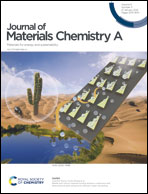Energy-level modulation of coumarin-based molecular donors for efficient all small molecule fullerene-free organic solar cells†
Abstract
In fullerene-free single-junction organic solar cells despite a small interfacial energy offset between the donor and acceptor materials efficient hole transfer occurs, resulting in power conversion efficiencies (PCE) >16%. Here, we demonstrate efficient organic solar cells by tuning of the electronic properties through simple structural modulation of coumarin-based electron donors. The OSCs with C2:BThIND-Cl:Y6 ternary blends exhibit a PCE of 13.54%, with an increased open circuit voltage (VOC) compared to the C1:BThIND-Cl:Y6-based devices (11.27%). Interestingly, an efficient charge transfer is revealed despite a reduced HOMO orbital offset of 0.02–0.04 eV between the C2 donor and BThIND-Cl and Y6 acceptors, resulting in a lower energy loss of 0.45 eV in ternary devices while still maintaining a maximum EQE of ∼80%@820 nm. The work demonstrates the importance of simple coumarin-based donors and their role in performance improvement for fullerene-free ternary OSCs by facilitating charge carrier transport with suppressed recombination.



 Please wait while we load your content...
Please wait while we load your content...